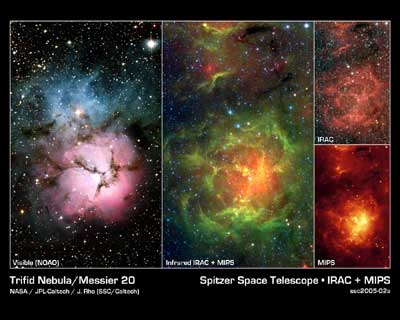Spitzer discovered 30 star embryos in the four dust and gas nuclei. A large number of star embryos were found in the two massive cores and a few were found in the other cores. This is one of the first times that clusters of embryos have been seen in individual nuclei at this early stage of stellar development.

When you look at the Trifid Nebula (in the photo), which is 5,400 light-years away from Earth, right in our cosmic neighborhood, with an ordinary telescope - it looks like a dark cloud behind which is a spot of bright light. Until now astronomers believed that in the dark regions of the nebula the conditions were not suitable for the formation of new stars. But the Spitzer telescope, which observes radiation in the infrared range, discovered about 30 "embryo" stars and 120 young stars in the nebula. "Spitzer is like an ultrasound of stars," Zhong-Hee Ru, an astronomer at the California Institute of Technology, said at a conference of the American Astronomical Society last week.
The Trifid Nebula is unique because it is dominated by a single central massive star. She is 300 thousand years old. The radiation and the stellar wind shaped the Triffid cloud into its current form. These winds also acted like shock waves and compressed gas and dust into dark nuclei, whose gravity caused more material to fall into them until stellar embryos were formed. Over time, the growing embryos will gain enough mass to reach ignition and emerge from their shells like chicken chicks emerge from eggs.
Because the nebula is home to a single massive star, it gives astronomers a rare opportunity to study an isolated family. All other discovered interstellar embryos have separated from the nebula's main star. "A look at the image shows exactly where these star embryos came from. We use colors to distinguish their ages. It's like examining the family tree of star generations.
As mentioned, Spitzer discovered 30 star embryos in the four dust and gas nuclei. A large number of star embryos were found in the two massive cores and a few were found in the other cores. This is one of the first times that clusters of embryos have been seen in single cores at this early stage of stellar development.
"In the nuclei where there are many embryos, we see that most of the mass and brightness of the group is near the center. This is consistent with this developmental stage where the stars compete for material and that the embryos in which there will be the largest amount of material will shine and become the largest stars." said Dr. Bertrand Lefloch from the observatory in Grenoble, France and co-researcher.
Spitzer also discovered about 120 small young stars that were hidden in the nebula's outer clouds. These newborn stars formed at about the same time as the central massive star and are actually its little brothers.
